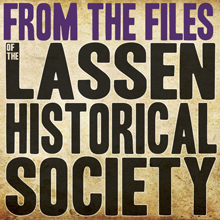

By Susan Couso
Through ‘fits and starts’ and plenty of stops, 1912 offered an abundance of hope that a railroad was coming to Susanville.
By June, thousands of workers were toiling to get the Fernley and Lassen rail line through town on its way to Westwood. Utah Construction Company crews began at Fernley, pushing northward, and another crew, under a subcontract held by James H. Maxey, worked to make the ‘cut’ through the Fred Cain property south of town.
By June 26th, Maxey’s workers began, and townsfolk could watch the excitement. It was mesmerizing entertainment for Susanvillians.
Residents could hear blasting from town, which brought great excitement and promise.

The Fernley end of the line advanced, mile by mile, and track was laid behind to bring heavy equipment to speed the work. By March 1913, they had reached Flanigan, and turned their attention toward Susanville.
Susanville citizens were thrilled with the advancing rails, and formed a welcoming committee, the Railroad Day Committee, to greet the railroad. Several arrival dates were reported, but the committee soon grew weary of the repeated anticipation, and by the time the tracklayers had finally reached town on April 26, 1913, there was not a committee member present.
The tracklayers were undeterred, took off for the local saloons, and everyone was satisfied.
But the big job lay ahead. The twenty-nine remaining miles to Westwood would be the most difficult of the whole project. The Utah Construction Company built a warehouse and a corral, and with the tracks in place, the heavy equipment followed.
Soon spectators could watch as the steam shovel poked its way west, and the incoming steam engines constantly moved back and forth shuttling equipment, supplies and workers.
Susanville had changed forever, and though the railway brought prosperity and opportunity, it also brought unwanted characters who had their own ideas about prosperity and opportunity. The saloons were booming, the jails were full, and numerous ‘unsavory’ characters littered the streets.
This may have been a pyrrhic victory after all.
As the work headed up the canyon, difficulties became obvious. It was necessary to blast through Cemetery Hill, and the constant explosions, especially at night, grew tiresome.
In May of 1913, as the blasting began, citizens rushed outside, fearing an earthquake. In July, the blasting threw a seven-pound rock more than 1,000 feet and another stone went crashing into the Methodist Church window.
As the blasting neared the old County Hospital near the end of Miller Road, the patients were moved out and housed in tents around Roop’s Fort. After four months of piercing through the hill below the cemetery, the workers pushed on up the canyon.
With the blasting complete, equipment was moved to the west end of the cut to continue work.
Two 20-ton ‘dinkey’ locomotives were moved up Main Street, and down to the end of Roop Street to begin the effort. One track section was laid, the engines moved onto it, the back section was pulled forward by horses, and then the engine moved forward again.

This ‘leapfrogging’ continued at a very slow pace until the locomotives were in place.
Steam shovels were moved through town following the same procedure, and heavy machine parts were moved in wagons. It made quite a sight as people, going about their daily routine, were startled by the giant equipment.
The railroad bed thus far had changed very little in altitude, but Westwood was situated about 2,000 feet higher than Susanville. This, and the fact that the rails had to withstand the heavy engines pulling great loads of lumber from Red River’s mill, made extensive planning necessary.
The route alongside the Susan River had seemed the logical and most efficient way to go, but the necessary 1.5% grade was going to be a problem. The river sharply turns in some places, and this mandated the construction of two tunnels to ease the way, and the rails crossed over the river twelve times, with giant girders spanning the void.
There were several casualties during the run to Westwood. Tunnel cave-ins, and explosive mishaps plagued the work. In September 1913, one of the dinkey engines was derailed. The escaping steam scalded the engineer, and one worker was crushed beneath the overturned mass of metal.
Worked continued on, in spite of the difficulties. On December 12th, 1913, the first of many work trains crossed over the new bridge at Devil’s Corral. Then, right before Christmas, a huge snowstorm blanketed the area, and all work between Devil’s Corral and Westwood ceased.

The snowstorm brought a halt to traffic to and from Westwood. The stores were depleted, kerosene was limited, and without the railroad’s completion, the only way to bring supplies was through the snow using teamsters with their horses and wagons. Even that was very difficult. By the end of the year, the snow was 10’ deep at Westwood Junction.
Questions arose as to the practicality of building a lumber town in such a harsh and isolated place. But even so, Southern Pacific received a permit by the State Railroad Commission to extend their Fernley & Lassen line on past Westwood for twenty-four miles, with the eventual destination of Klamath Falls, Oregon.
As 1914 arrived, a warm rain fell near Susanville. The melting snow inundated the Susan River and the furious stream swelled with debris. The rail bridges needed to be cleared of every sort of flotsam. But the snow lingered between Devil’s Corral and Westwood.
To expedite the work, an army of 350 men was hired to shovel a path through the snow and clear fallen trees and rockslides. It was tough work, but the might of man surged on. Early February found the track eleven miles from the lumber town, but on Saturday, February 21st, 1914, the tracklayers reach Westwood.
The first train from Susanville brought a shipment of hay for the hungry work horses, and cattle stationed in Westwood. There was still three feet of snow on the ground, and the animals, necessary for work and feed, were suffering. With 950 workmen cutting timber and running the mill, these animals were vital.
Westwood was linked to the rest of the world. Lumber was shipped with as many as 40 cars per day, and the town was thriving. People could depart Westwood on the train at 11:30 a.m. and arrive in Reno by 7:25 p.m. From a little lumber town in the midst of the wilderness, you could go anywhere, and once again, the world had changed.






